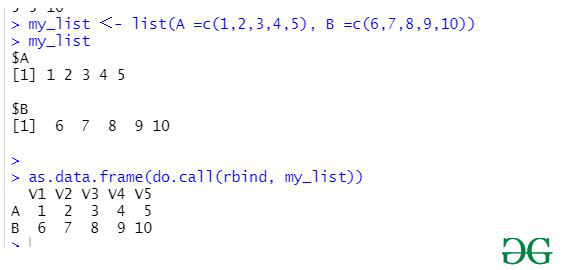在 R 中将向量列表转换为 DataFrame
在本文中,我们将讨论如何使用 R 编程语言中的不同函数将给定的向量列表转换为 Dataframe。
对于下面讨论的所有方法,由于其功能性,很少有函数是通用的。让我们先讨论它们。
- as.data.frame()是将给定的向量列表转换为 R 语言中的 DataFrame 的最简单方法之一,只需调用 as.data.frame()函数并传递所需的参数,进一步该函数将是返回从之前给出的向量列表转换而来的 DataFrame。
Syntax: as.data.frame(x, row.names = NULL, optional = FALSE, …)
- 此外,对于 as.data.frame()函数,用户还需要调用 do.call()函数,该函数在这里用于从名称或函数以及要传递给的参数列表构造和执行函数调用它。
Syntax: do.call(what, args, quote = FALSE, envir = parent.frame())
Parameters:
- what:-either a function or a non-empty character string naming the function to be called.
- args:a list of arguments to the function call. The names attribute of args gives the argument names.
- quote:-a logical value indicating whether to quote the arguments.
- envir:-an environment within which to evaluate the call.
方法一:使用 cbind()
cbind()函数代表列绑定。此函数可用于按列组合多个向量、矩阵或 DataFrame。
Syntax: cbind(x1, x2, …, deparse.level = 1)
在这种方法中,将单个向量视为一列,然后将这些列组合起来形成一个数据帧。
例子:
R
my_list <- list(A =c(1,2,3,4,5),
B =c(6,7,8,9,10))
my_list
as.data.frame(do.call(cbind, my_list))R
my_list <- list(A =c(1,2,3,4,5),
B =c(6,7,8,9,10))
my_list
as.data.frame(do.call(rbind, my_list))输出:

方法 2:使用 rbind()
rbind()函数代表行绑定。此函数可用于按行组合多个向量、矩阵或 DataFrame。
Syntax: rbind(x1, x2, …, deparse.level = 1)
Parameters:
x1, x2: vector, matrix, DataFrames
deparse.level: This value determines how the column names generated. The default value of deparse.level is 1.
在这种方法中,每个向量被视为一行,然后将这些行组合起来形成一个数据帧。
例子:
电阻
my_list <- list(A =c(1,2,3,4,5),
B =c(6,7,8,9,10))
my_list
as.data.frame(do.call(rbind, my_list))
输出:
